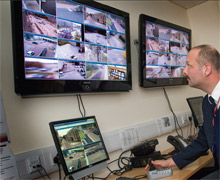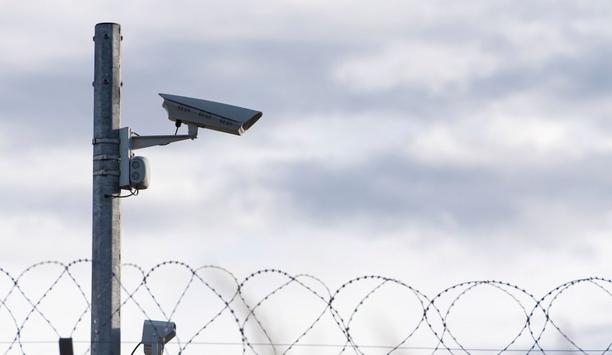 Mission
Mission
After the University of Aberdeen conducted a strategic review of security, the university decided to rationalize four stand-alone analogue CCTV systems and establish a central control room for the entire university. The four systems varied in age and the university wanted a single system, which would feature new cameras as well as including existing analogue cameras. The system would have to offer the flexibility to cope with future expansion, and to eliminate stand-alone proprietary systems that risked obsolescence.
Solution
William Stevenson, Assistant Estates Director for Support Services at the University of Aberdeen led the project for the university. He appointed surveillance system integrators Arthur McKay, who had extensive experience in network video projects. Arthur McKay installed 20 AXIS 233D+ Network Cameras, with 10 AXIS 241Q Encoders deployed to convert 35 existing analogue-based CCTV cameras. A new Virtual Local Area Network (VLAN) carried video data from a total of 55 cameras deployed in the new system. Images were stored on a RAID 5 SCSI device with 12 Terabytes (TB) of data capacity, with Milestone Enterprise network video recording software Version 6.0e with Smart Client used for management and viewing of images.
Result
Image quality has improved dramatically; ensuring that images submitted to the local police can be used as evidence. Thirty-five of the existing analogue cameras that were still serviceable have been integrated into the new surveillance system to keep costs down. Morale amongst the security team has improved as the new technology helps make their job easier. The system can be scaled further to accommodate growth across the university's campus.
"We have been very impressed with the image quality offered by the new Axis system. The previous system delivered images, which rarely identified individuals caught on camera in a way in which they could be positively identified. But we now have absolute certainty that those who are captured will be identifiable which is very reassuring, particularly if we need to show the images to the local police if a crime has been committed," said William Stevenson, Assistant Estates Director for Support Services, University of Aberdeen.
Managing a growing university
Founded in 1495, the University of Aberdeen is the UK's fifth oldest university. Today it boasts some 13,900 students, and is currently going through rapid expansion with three new buildings due to be opened in the next few years, after successfully raising over £80 million and with a new campaign to raise a further £150 million by 2010. It is also partway through the largest Wi-Fi deployment in Scotland and the second largest in the UK, with some 1,000 Trapeze Wi-Fi access points installed.
Security and surveillance is the responsibility of the Estates Section's Support Services department, employing a total of 150 people out of the 240 total Estates Section staff. Support Services provides all cleaning, portering and security services to the university. A total of 30 personnel today provide surveillance monitoring and physical patrolling throughout the campus around the clock.
Surveillance challenges
William Stevenson, Assistant Estates Director for Support Services at the University of Aberdeen was in charge of the strategic review carried out in 2005 looking at the surveillance requirements for the university. Some immediate issues needed to be addressed; the control room had been outgrown as over time more equipment and staff had come on board. Four separate stand-alone CCTV systems were in operation, with proprietary cameras and components requiring spares and maintenance from different manufacturers. A new system would have to be easily scalable to accommodate the future expansion plans for the university and be implemented with minimal disruption.
Stevenson had seen the success of IP-Surveillance deployments elsewhere in the education sector. The solution would need to capitalize on some 35 existing analogue CCTV cameras as well as introducing new cameras.
Stevenson reduced the list of possible integrator companies down to two, and chose respected Scottish building services and facilities management company Arthur McKay. His chosen integrator already had extensive experience in working with IP-Surveillance and had worked previously with both Axis and video management specialists Milestone Systems.
Simple and effective
Arthur McKay installed 20 new AXIS 233D+ Network Cameras and integrated 35 existing analogue cameras into the IP-Surveillance system through the use of AXIS 241Q (Quad) Video Encoders. All data is carried on a VLAN, with the university's extensive network supplying 100 megabits per second (Mbps) of bandwidth to all cameras via one-gigabit (GB) link at the server end.
The university moved to a new, larger security office in January 2007 as the focal point for an upgrade of its surveillance system; all images are now viewed on two Samsung 42-inch LCD screens capable of displaying 16 cameras on each screen comfortably. Images are collected in MPEG-4 format, reducing bandwidth and storage requirements by at least 50% compared with JPEG. Images are then stored on a RAID 5 SCSI device which is capable of holding up to 12 TB of data, with the 55 cameras currently using nine TB of storage space to collect two weeks worth of images.
Arthur McKay was able to make the new cameras live alongside the original CCTV cameras that were operating via Axis video encoders in a matter of days. The system can now be expanded as the campus grows, with plans for 16 new network cameras to be deployed campus-wide in the next three years. It can also exploit its extensive investment in network and cabling infrastructure going forward.















